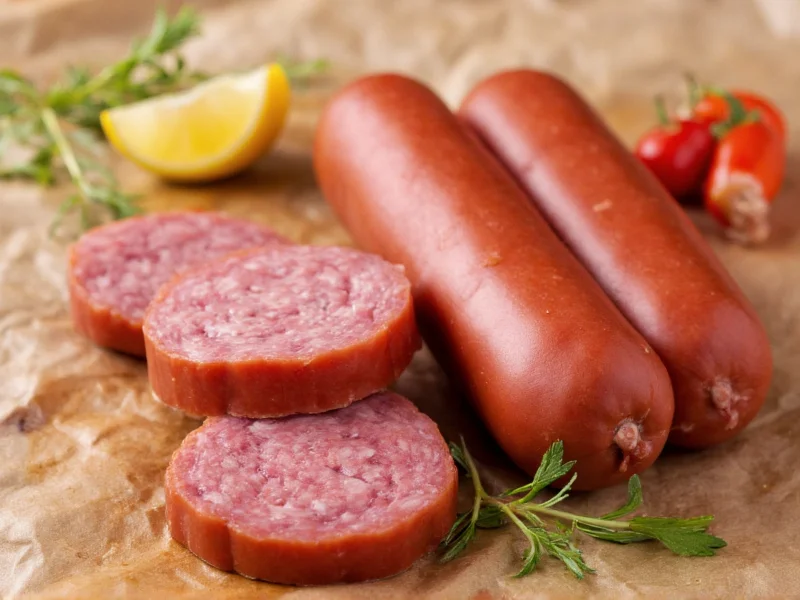Understanding what makes summer sausage unique begins with its preservation method. Unlike fresh sausages that require immediate cooking, summer sausage undergoes a controlled fermentation and drying process that lowers its pH and moisture content, creating an environment inhospitable to harmful bacteria. This traditional preservation technique allowed European immigrants to enjoy sausage throughout warmer months—hence the "summer" designation.
Historical Origins and Traditional Preparation
Summer sausage traces its roots to Central and Eastern European food preservation techniques developed before refrigeration. German and Swiss immigrants brought these methods to America in the 19th century, adapting recipes to available ingredients. Traditional preparation involves grinding meat (typically 75% pork and 25% beef), mixing with curing salts, sugar, mustard seed, black pepper, and other seasonings, then stuffing into casings.
The critical fermentation stage follows, where lactic acid bacteria lower the pH to around 4.6-5.0 over 24-48 hours. This acidification creates summer sausage's distinctive tangy flavor while inhibiting pathogens. After fermentation, the sausage undergoes a gentle smoking or cooking process at low temperatures (130-150°F) to achieve an internal temperature of 155°F, followed by air-drying to reach the proper moisture-to-protein ratio.
Key Characteristics of Quality Summer Sausage
Authentic summer sausage displays several distinguishing features that set it apart from other cured meats:
| Characteristic | Description | Why It Matters |
|---|---|---|
| Texture | Firm but sliceable, slightly springy | Indicates proper moisture content and protein binding |
| Color | Deep pink to reddish-brown | Shows appropriate curing without over-smoking |
| Flavor Profile | Tangy with balanced seasoning | Reflects successful fermentation process |
| Moisture Content | Less moist than fresh sausage, not dry | Proper drying prevents spoilage while maintaining palatability |
Storage Guidelines for Optimal Freshness
One of summer sausage's most valued qualities is its shelf stability. Unopened summer sausage stored in a cool, dry place maintains quality for 3-6 months without refrigeration. This shelf-stable characteristic made it historically valuable for summer consumption when fresh meat spoiled quickly.
After opening, proper storage becomes essential. Transfer unused portions to an airtight container or wrap tightly in plastic wrap, then refrigerate. Properly stored, opened summer sausage remains fresh for 2-3 weeks in the refrigerator. For extended storage, slice and freeze portions in freezer bags for up to 2 months—though texture may slightly degrade after thawing.
Perfect Pairings and Serving Suggestions
Summer sausage's robust flavor profile makes it exceptionally versatile for pairing. The tangy notes complement creamy cheeses like aged cheddar, gouda, or brie, creating a balanced flavor experience. When planning what to serve with summer sausage, consider these ideal combinations:
- Cheese pairings: Sharp cheddar, smoked gouda, and creamy havarti enhance summer sausage's flavor profile
- Crackers and breads: Water crackers, rye bread, or baguette slices provide neutral bases that don't compete with the sausage
- Accompaniments: Grainy mustard, cornichons, dried fruits, and honey balance the savory notes
- Beverage matches: Medium-bodied red wines, crisp lagers, or hard ciders complement the flavors
For entertaining, arrange sliced summer sausage on a charcuterie board with complementary elements. Thinly slice against the grain for optimal texture, and allow the sausage to come to room temperature before serving to maximize flavor release.
Popular Variations and Flavor Profiles
While traditional summer sausage features a straightforward blend of pepper, mustard seed, and curing salts, modern variations offer diverse flavor experiences. Popular iterations include:
- Peppered summer sausage: Contains visible cracked black pepper throughout
- Garlic summer sausage: Infused with roasted garlic for deeper flavor complexity
- Jalapeño summer sausage: Adds mild heat that complements the tangy base
- Honey summer sausage: Balances tanginess with subtle sweetness
- Wild game summer sausage: Made with venison, elk, or other game meats
When selecting summer sausage, examine ingredient lists for quality indicators. Premium products typically contain simple ingredients without artificial preservatives beyond the necessary curing salts. Avoid products listing fillers like corn syrup, excessive sodium, or artificial flavors that compromise traditional preparation methods.
Common Questions About Summer Sausage
Many consumers have specific questions about summer sausage characteristics and usage. Understanding these aspects helps maximize enjoyment of this traditional food product.
Conclusion
Summer sausage represents a practical solution to food preservation that has evolved into a beloved culinary tradition. Its distinctive tangy flavor, firm texture, and shelf stability make it a versatile option for casual snacking, charcuterie boards, or incorporation into recipes. By understanding proper storage techniques, ideal pairings, and quality indicators, consumers can fully appreciate this traditional food product while enjoying it safely. Whether enjoyed as part of a quick lunch, picnic fare, or sophisticated appetizer spread, summer sausage continues to earn its place in modern food culture while honoring its historical roots in food preservation.











 浙公网安备
33010002000092号
浙公网安备
33010002000092号 浙B2-20120091-4
浙B2-20120091-4